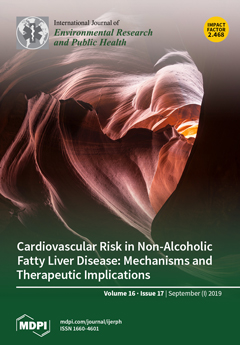Widespread application of silica nanoparticles (nSiO
2) and ubiquitous metalloid arsenic (As) may increase their chances of co-exposure to human beings in daily life. Nonetheless, studies on combined effects of nSiO
2 and As in human cells are lacking. We investigated the
[...] Read more.
Widespread application of silica nanoparticles (nSiO
2) and ubiquitous metalloid arsenic (As) may increase their chances of co-exposure to human beings in daily life. Nonetheless, studies on combined effects of nSiO
2 and As in human cells are lacking. We investigated the co-exposure effects of nSiO
2 and As in human liver (HepG2) and human fibroblast (HT1080) cells. Results showed that nSiO
2 did not cause cytotoxicity. However, exposure of As caused oxidative stress and apoptosis in both types of cells. Interesting results were that co-exposure of a non-cytotoxic concentration of nSiO
2 significantly augmented the As induced toxicity in both cells. Intracellular level of As was higher in the co-exposure group (nSiO
2 + As) than the As group alone, suggesting that nSiO
2 facilitates the cellular uptake of As. Co-exposure of nSiO
2 and As potentiated oxidative stress indicated by pro-oxidants generation (reactive oxygen species, hydrogen peroxide and lipid peroxidation) and antioxidants depletion (glutathione level, and glutathione reductase, superoxide dismutase and catalase activities). In addition, co-exposure of nSiO
2 and As also potentiated mitochondria-mediated apoptosis suggested by increased expression of
p53,
bax,
caspase-3 and
caspase-9 genes (pro-apoptotic) and decreased expression of
bcl-2 gene (anti-apoptotic) along with depleted mitochondrial membrane potential. To the best of our knowledge, this is the first study showing that co-exposure of nSiO
2 and As induced augmentation of oxidative stress and mitochondria-mediated apoptosis in HepG2 and HT1080 cells. Hence, careful attention is required for human health assessment following combined exposure to nSiO
2 and As.
Full article





